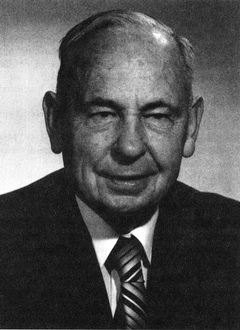Henry Eyring
Henry Eyring, father of Henry B. Eyring], was a scientist in the field of chemical physics. He was born on February 20, 1901, in the prosperous Mormon community of Colonia Juarez, Mexico (about 100 miles south of Columbus, New Mexico). He was a third generation Mormon, his grandparents on both sides having participated in the early migration (1850-60), first to Salt Lake City and then to outlying communities. [1] Mormon families moved to Mexico during the years of persecution of Utah Latter-day Saints over the doctrine and practice of polygamy.
Henry Eyring's father was a successful cattle rancher, and Eyring became comfortable on horseback at a very young age. However, in 1910, the Mexican revolution began, endangering the Mormon settlers. Nearly 5,000 Mormons moved to El Paso, Texas, in 1912 to escape the effects of the war. Most expected the move to be temporary, expecting to move back into their homes in Mexico. Because of this, they had left most of their possessions behind and lived with difficulty in exile. However, they were unable to return, and Eyring's father eked out a living in Texas and Arizona before purchasing a small farm in Pima, Arizona. Gradually, the family's fortunes improved. Eyring had left Mexico the summer after he finished fifth grade. He missed a year of school in El Paso, but then skipped several grades in Arizona. He attended Gila Academy, a church school near Pima, graduating in 1919.
Eyring excelled in mathematics and science, and won a scholarship to the University of Arizona, where he studied mining engineering. He worked at menial jobs and was actually able to send money home to his family. After his junior year, Eyring got some hands-on experience working at a mine. He was exposed to the dangers of mining, observed some serious accidents, and realized that if he were in mining management, he would be sending men into these dangerous situations. He changed his major to metallurgy. He graduated in 1923 with a B.S. in mining engineering. He continued his studies at the University of Arizona and obtained a master's degree in metallurgy in the spring of 1924. He made another turn in his career and returned to the University of Arizona as a chemistry instructor for the academic year 1924-25. "Here his promise as a chemist was recognized by several faculty members and he was encouraged to go on for a Ph.D. He was accepted as a graduate student at Berkeley, where he received his Ph.D. in 1927. His thesis work was under the direction of Professor George F. Gibson and involved a study of the ionization of various gases by alpha particles from polonium, as well as the stopping powers of these gases" (nap.edu).
Eyring became a chemistry instructor at the University of Wisconsin, continuing his work on the interaction of gases with alpha particles. He received a postdoctoral appointment in the laboratory of Farrington Daniels, where he studied the decomposition of N2O5 in various solvents. It was here that he began working in chemical kinetics, a field that was to remain so central to his interests and reputation for the rest of his life. His work with Daniels resulted in the award of a National Research Council fellowship at the Kaiser Wilhelm Institute in Berlin from the summer of 1929 until the summer of 1930. Eyring then returned to Berkley. On the basis of his groundbreaking work in chemistry, Eyring was invited to Princeton and worked with the University for many years. Although he was not promoted to the rank of full professor until 1938, his research activities during this period were intense and it was at this time that his reputation became established. Eyring's ideas and expertise, indeed his genius, was employed in many areas of chemistry, and he authored many papers. (For more detail regarding his work, go to nap.edu.) The Princeton years from 1941 to 1947 resulted in fifty more papers bearing Eyring's name. Eyring was elected to the National Academy of Sciences in 1945.
- In 1946 Eyring was approached by the University of Utah to explore his interest in becoming the dean of its graduate school, with the aim of building a major research activity at the university. The attraction of Salt Lake City was strong. While at Wisconsin Eyring had married Mildred Bennion, also a devout Mormon. The marriage had produced three sons, Edward Marcus, born in Oakland in 1931, Henry Bennion born in Princeton in 1933, and Harden Romney born in Princeton in 1936. Mildred especially was concerned about the problems of raising her sons in New Jersey, so far from the center of the Mormon faith. Professor Taylor was unable to convince either Eyring or his wife that it was in Eyring's best interests to remain in Princeton. And so began the final thirty-five years of Eyring's career, in which highly successful activities as an administrator were added to a continuing productive scientific output. In Eyring's Utah years approximately 485 papers appeared bearing his name.
